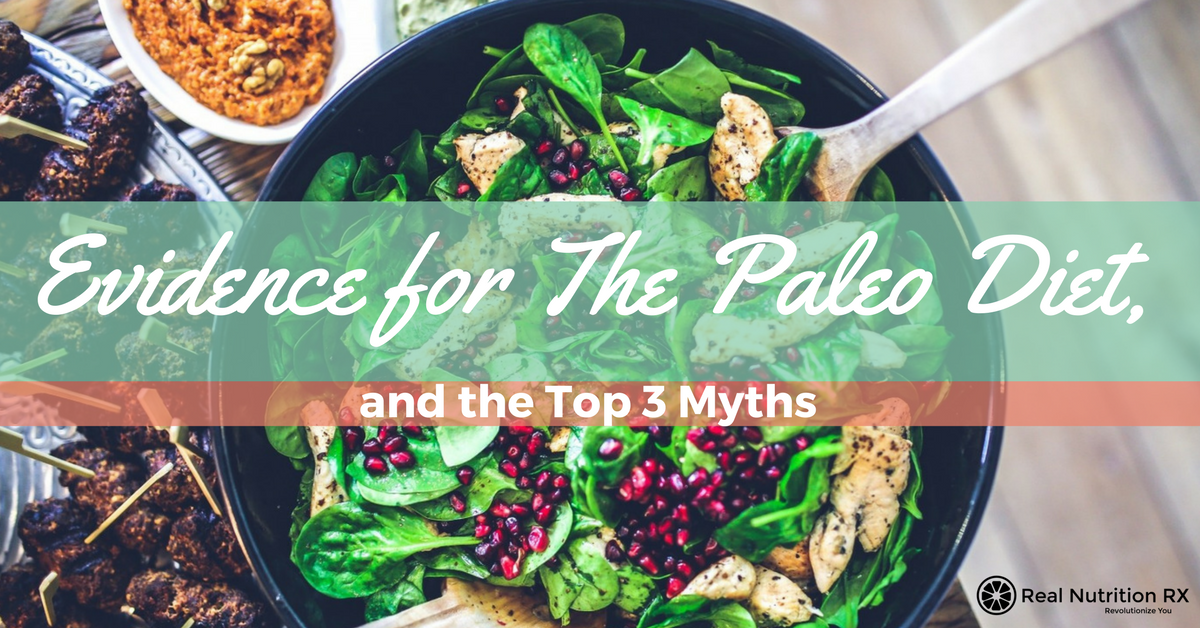
It’s no secret that there is an epidemic of chronic disease in the modern world. Western nations continue to experience sharply rising rates of obesity and diabetes, while cardiovascular disease remains the leading cause of death (1, 2, 3, 4). The public is looking for answers and many of them are looking to ancestral or ‘paleo’ diets as a way to improve their health. However, ancestral diets are often dismissed by professional nutritionists as a ‘fad diet’ – leaving the public to turn to the internet, popular press, or lay nutritionists for advice. Unfortunately, the guidance they find is often poor or even dangerous.
This is a shame, considering that a well-designed, individualized ancestral diet can be an incredibly powerful healing tool. As an example, Dr. Terry Wahls used her version of an ancestral diet to reverse her debilitating Multiple Sclerosis (10, 23). I use ancestral diets with great success in my private practice, as a part of a broader functional and integrative approach. Here I will share some of the research behind ancestral diets and will describe how they can be used professionally.
What are Paleo/Ancestral Diets?
For over 200,000 years, humans subsisted on a diet consisting mostly of meat, poultry, seafood, eggs, fruit, vegetables, nuts, seeds, herbs and spices. Although there was some variation by area, there were obviously no processed foods. Then, agriculture began around 11,000 years ago. That is only 366 generations ago, or 0.5% of human history. (6)
The premise behind ancestral diets is that there has not been enough time or genetic pressure for humans to adapt to the foods that came with agriculture. Examples of these ‘Neolithic’ foods include grains, industrial seed and vegetable oils, soy, processed sugar, and food additives (i.e. dyes, gums, and preservatives). Dairy and legumes (beans) remain a grey area based on genetics, personal tolerance, and types/preparations of those foods.
We now consume at least 70% of our energy from foods that were never consumed by our ancestors (14). The idea behind ancestral diets is to return to eating the foods that our bodies are genetically programmed to expect.
Show Me the Data
The benefits of abandoning these Neolithic foods in favor of ancestral ones are no less than astounding. Scientific studies have shown that ancestral diets:
- Improve risk factors for metabolic syndrome. Ancestral diets lower waist size, total cholesterol, LDL cholesterol, blood pressure, liver fat, and fasting blood glucose while increasing HDL. This effect is found for a wide variety of test subjects – healthy controls, obese postmenopausal women, type II diabetics, and cardiovascular disease patients (9, 14, 16, 18)
- Improve glucose tolerance and decrease waist size more powerfully than a Mediterranean Diet (15)
- Lower risk factors for cardiovascular disease – body weight, BMI, waist circumference, blood pressure, plasminogen activator inhibitor-1 (a marker of atherosclerosis) and CRP (a marker of inflammation) (12, 14, 24)
- Improve blood glucose control and lower hemoglobin A1C in type II diabetics (12)
Amazingly, these impressive results were found in relatively short studies – 10 days to 3 months in duration.
But I Heard that Paleo Diets….
Myth: They are overly-restrictive
Ancestral diets should be used like an elimination diet. This is where a RD’s ability to provide individualized care is so essential. The professional’s role is to decide if a trial may benefit the patient, then to design a personalized diet to be followed for a specific period of time. Finally, they should guide the patient through reintroducing foods in a calculated way. As an example of this, quality dairy foods are well-tolerated by many people of northern European ancestry. I will often trial dairy foods of increasing lactose content after 30 days dairy-free. The end goal is to get the patient to the broadest possible diet while maintaining their health improvements.
Also note that ancestral diets provide increased nutrient density. The nutrient-rich foods that are added are just as (if not more) important than the foods that are removed. Some of the original research of ancestral diets found that patients experienced remarkable health improvements just by adding traditional foods, even when they did not remove flour and refined sugar (17). Keep in mind that to say that ancestral diets are nutrient-deficient is to say that humans went 99.5% of their history without sufficient nutrients.
Myth: They contain way too much animal protein.
In fact, a well-balanced ancestral diet is composed of mostly plants, with a small to medium serving of high-quality meat, poultry, seafood, or eggs at most meals. Interestingly, though, hunter-gatherers did consume 65% of their energy from animal sources on average and were relatively free from signs or symptoms of cardiovascular disease and diabetes (7, 13). A well-planned ancestral diet usually does not increase animal protein, but does emphasize quality and nose-to-tail eating. For example, liver is encouraged as a source of vitamins A and K, iron, copper, zinc, selenium, potassium, folate, and vitamin B-12. Notably, these nutrients are often lacking in the modern diet (19).
Myth: They contain way too much fat and, thus, may increase risk of cardiovascular disease.
Modern-day hunter gatherers eat fairly high-fat diets, at least as high as is currently consumed by western societies, with rare incidence of cardiovascular disease (7, 8, 13). The amount of dietary cholesterol that they consume is similar or even higher to that of Americans (8). It is important to understand, though, that dietary cholesterol has been shown not to have a major effect on serum cholesterol and risk of heart disease (13, 19). In fact, dietary fat in general has been exonerated as being unhealthful for most individuals when it comes from appropriate sources and is part of an overall healthful diet (11, 22).
Hunter gatherers consumed much more omega-3 and less omega-6 fats, at a ratio of 1:2 instead of the modern ratio of 1:10 (8). Omega-3 fats reduce inflammation, while excess intake of omega-6 fats (such as found in canola, corn, or vegetable oil) promotes inflammation and, thus, heart disease. Traditional societies consumed only game animals, which have more mono and polyunsaturated fats and less saturated fat, as well as more omega-3 and less omega-6 fats (13). Hence, grass-fed and free range meat should be consumed if at all possible.
Traditional societies also consumed high amounts of plants, which are cardio protective. They consumed no refined carbohydrates, which increase risk factors for cardiovascular disease (19).
Myth: They are really low in carbohydrate.
Ancestral diets are agnostic with regard to carbohydrate, and there is massive variation among ancestral populations with regard to their carbohydrate intake. Traditional societies remain lean with a large range of carbohydrate intake (6). However, most ancestral populations consume high amounts of dietary fibre; some groups consume in excess of 100 grams per day (8). On average, adults in the UK consume 18 grams per day (5).
Thus, an important feature of ancestral diets is that they support a healthy gut microbiota, which is protective against chronic disease (20). The fibre in ancestral carbohydrate sources nourish the microbiome, whereas refined grains/flour and sugar starve the microbiome and promote leptin resistance (20, 21). Unfortunately, refined carbohydrates make up the vast majority of the carbohydrate consumption of modern societies (21).
Ancestral diet ‘beginners’ often unintentionally eat too few carbohydrates; they aren’t used to eating the amount of fruit and vegetables that is required. Thus, professionals should ensure that carbohydrate intake is appropriate for that individual (accounting for their activity level, insulin sensitivity, gender, and age).
Worth a Second Thought
Ancestral diets play an important role in a broader integrative and functional approach to nutrition. They are, in fact, the original diet. Overall, people are catching on to the fact that old paradigms do not protect them from chronic disease, and they are looking for health professionals who can help them find an effective approach. I am happy to share more details and resources with colleagues. You can contact me via my website: www.RealNutritionRX.com
Warm wishes,

References:
- DiabetesInfo Facts and Figures about Diabetes. Available at: http://www.diabetes-info.co.uk/what-is-diabetes/facts-and-figures-about-diabetes.html (Accessed: 11 October 2016).
- Macmillan Cancer Support (2016a) Cancer statistics – evidence – Macmillan cancer support – Macmillan cancer support. Available at: http://www.macmillan.org.uk/about-us/what-we-do/evidence/cancer-statistics.html (Accessed: 11 October 2016).
- NHS Choices (2014) Latest obesity stats for England are alarming. Available at: http://www.nhs.uk/news/2013/02February/Pages/Latest-obesity-stats-for-England-are-alarming-reading.aspx (Accessed: 11 October 2016).
- NHS Choices (2016b) Coronary heart disease. Available at: http://www.nhs.uk/Conditions/Coronary-heart-disease/Pages/Introduction.aspx (Accessed: 11 October 2016).
- NHS Choices (2016c)Why is fibre important?Available at: http://www.nhs.uk/chq/pages/1141.aspx?categoryid=51 (Accessed: 11 October 2016).
- Carrera-Bastos, P. and Fontes (2011a) ‘The western diet and lifestyle and diseases of civilization’, Research Reports in Clinical Cardiology, p. 15. doi: 10.2147/rrcc.s16919.
- Cordain, L., Eaton, S.B., Miller, J.B., Mann, N. and Hill, K. (2002) ‘The paradoxical nature of hunter-gatherer diets: Meat-based, yet non-atherogenic’, European Journal of Clinical Nutrition, 56(s1), pp. S42–S52. doi: 10.1038/sj.ejcn.1601353.
- Eaton, S. (2006) ‘The ancestral human diet: What was it and should it be a paradigm for contemporary nutrition?’, The Proceedings of the Nutrition Society., 65(1), pp. 1–6.
- Frassetto, L.A., Schloetter, M., Mietus-Synder, M., Morris, R.C. and Sebastian, A. (2009) ‘Metabolic and physiologic improvements from consuming a paleolithic, hunter-gatherer type diet’, European Journal of Clinical Nutrition, 63(8), pp. 947–955. doi: 10.1038/ejcn.2009.4.
- Gnuechtel, A. (2016) Next event. Available at: http://functionalforum.com/september-2016-functional-forum/ (Accessed: 6 October 2016).
- Hyman, M. (2016) Eat fat, get thin: Why the fat we eat is the key to sustained weight loss and vibrant health. United States: Little, Brown & Company.
- Jönsson, T., Granfeldt, Y., Ahrén, B., Branell, U.-C., Pålsson, G., Hansson, A., Söderström, M. and Lindeberg, S. (2009) ‘Beneficial effects of a Paleolithic diet on cardiovascular risk factors in type 2 diabetes: A randomized cross-over pilot study’, Cardiovascular Diabetology, 8(1), p. 35. doi: 10.1186/1475-2840-8-35.
- Konner, M. and Eaton, S.B. (2010) ‘Paleolithic nutrition: Twenty-Five years later’, Nutrition in Clinical Practice, 25(6), pp. 594–602. doi: 10.1177/0884533610385702.
- Kowalski, L. and Bunko, J. (2012) ‘Evaluation of biological and clinical potential of paleolithic diet’, Rocz Panstw Zakl Hig, 63(1), pp. 9–15.
- Lindeberg, S., Jönsson, T., Granfeldt, Y., Borgstrand, E., Soffman, J., Sjöström, K. and Ahrén, B. (2007) ‘A Palaeolithic diet improves glucose tolerance more than a Mediterranean-like diet in individuals with ischaemic heart disease’, Diabetologia, 50(9), pp. 1795–1807. doi: 10.1007/s00125-007-0716-y.
- Manheimer, E.W., van Zuuren, E.J., Fedorowicz, Z. and Pijl, H. (2015) ‘Paleolithic nutrition for metabolic syndrome: Systematic review and meta-analysis’, American Journal of Clinical Nutrition, 102(4), pp. 922–932. doi: 10.3945/ajcn.115.113613.
- Price, W.A. (1939) Nutrition and Physical Degeneration: A Comparison of Primative and Modern Diets and Their Effects. PB Hoeber, Incorporated.
- Ryberg, M., Sandberg, S., Mellberg, C., Stegle, O., Lindahl, B., Larsson, C., Hauksson, J. and Olsson, T. (2013) ‘A Palaeolithic-type diet causes strong tissue-specific effects on ectopic fat deposition in obese postmenopausal women’, Journal of Internal Medicine, 274(1), pp. 67–76. doi: 10.1111/joim.12048.
- Scientific Report of the 2015 Dietary Guidelines Advisory Committee Part D. Ch 1: Food and nutrient Intakes (2015) Available at: http://health.gov/dietaryguidelines/2015-scientific-report/06-chapter-1/d1-2.asp (Accessed: 5 June 2016).
- Sonnenburg, J. and Sonnenburg, E. (2016) The good gut: Taking control of your weight, your mood, and your long-term health. United States: Penguin Books.
- Spreadbury, I. (2012) ‘Comparison with ancestral diets suggests dense acellular carbohydrates promote an inflammatory microbiota, and may be the primary dietary cause of leptin resistance and obesity’, Diabetes, Metabolic Syndrome and Obesity: Targets and Therapy, , p. 175. doi: 10.2147/dmso.s33473.
- Teicholz, N. (2014) The big fat surprise: Why butter, meat, and cheese belong in a healthy diet. United States: Simon & Schuster Children’s Publishing.
- Terry Wahls M.D. (2016) Available at: http://terrywahls.com/ (Accessed: 6 October 2016).
- Österdahl, M., Kocturk, T., Koochek, A. and Wändell, P.E. (2007) ‘Effects of a short-term intervention with a paleolithic diet in healthy volunteers’, European Journal of Clinical Nutrition, 62(5), pp. 682–685. doi: 10.1038/sj.ejcn.1602790.
